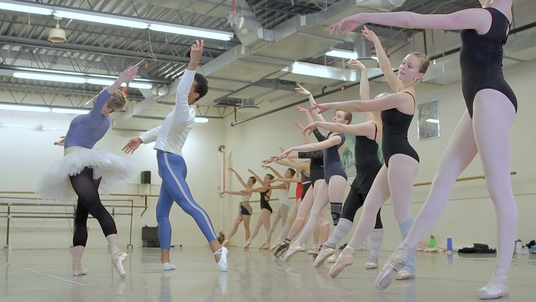
By Elsa Johnson & Victor Lucas
We drove out to Tri-C East last Saturday to see the annual spring repertory concert of City Ballet of Cleveland. Vic takes ballet classes at Cleveland City Dance there, and this year they’re bringing in alumna Diana Yohe as guest artist in Paquita.
The first piece on the program was executive and artistic director Courtney Laves-Mearini’s perennial recital piece, Dr. Coppelia’s Workshop. An excerpt from the well-known music by Leo Delibes provides accompaniment for the first part of Act II in which Swanhilda and her friends enter the inventor’s workshop without authorization and come upon his mechanical dancing dolls.
As in most versions of this oft-reworked Romantic ballet, there is dancing by Chinese dolls, Highland dolls and so on, each group portrayed here by what are apparently different classes and different levels in the school, each group getting its turn in the figurative spotlight. The dancers were a mixed group, from elementary school-aged dancers to high school-aged pre-professionals, many of whom will soon be off to university dance programs and dance training programs. The Chinese dolls danced in precise unison but just out of synch with the music, enhancing the impression of animated but insensate dolls.
As Swanhilda and her friends, Elizabeth Healey and Caitlin Cullina, Anna Herbst, Hannah Lowenkamp and Sage Smith succeeded in portraying characters much like themselves without stealing the show as they watched and danced little riffs off the younger dancers. They also brought characterization and emotion to their (silent!) pointe dancing, an achievement.
What is it about a dancer pretending to be an animated mechanism, a dancing doll? The idea has appeared again and again in 19th-century ballets. As the Coppelia doll in last Saturday’s concert, Lydia Fedor reminded us how amusing — and spooky — that illusion can be.
For the second piece on the program, Steel Dreams, ballet mistress Andrea Blankstein-Otloski choreographed an abstract ballet entirely en pointe to New Age music by Piano Guys. Rebecca Fleisher and Spencer Waldeck joined three of the pointe dancers from Dr. Coppelia’s Workshop and showed clean turns and confident dancing in the innovative neoclassical choreography.
In Lara’s Song, Laves-Mearini created pleasing patterns of lyric ballet movement for 7 dancers in soft ballet slippers, a nice showpiece for the young dancers.
Sometimes it’s a mystery to us why we like a piece so much. If Music Be the Food of Life, choreographed and costumed by Amy McKenney, presents two tall girls in pointe shoes and long, sheer nightgowns — Lowenkamp and Spencer Waldeck — and five smaller girls in bare feet, bloomers and blouses. They perform ballet and modern dance movements to baroque English composer Henry Purcell’s If Music Be the Food of Love, written in the 1690s.
The bare feet and the movement vocabulary put us in mind of Mark Morris, who has choreographed notable dances on Purcell and another English Baroque composer, George Frideric Handel. The simple but well-executed costumes seemed period-appropriate to the 17th-century music. No story, no characterization, and no technical tricks, but very satisfying. We’re watching for McKenney’s work from now on.
Commenting on Paquita as a cornerstone of ballet, George Balanchine wrote in his Complete Stories of the Great Ballets, “We do not make dances like this now, perhaps, but we could make nothing if we had not had dances like these by (Marius) Petipa to teach us.” The dancing in Paquita is difficult but very rewarding to watch.
Like most American companies, City Ballet of Cleveland presents a sort of greatest hits from Paquita, including the Mazurka and the Grand Pas added by Petipa in 1881, and the Seven Variations, added later with music and choreography from various sources. As in Don Quixote, faux Spanish dancing (mostly) by Petipa set to faux Spanish music (mostly) by Ludwig Minkus creates a heady mix.
An ensemble of six dancers led by Rebecca Fleisher and Regina Pietraroia negotiated the fast and tricky Mazurka. The Seven Variations followed, each a satisfying composition in itself and all of them together building momentum to the guest artists that followed. Laves-Mearini and Blankstein-Otloski, credited with the restaging, stayed with the traditional choreography and the dancers rolled through the difficult material with scarcely a hitch, quite an achievement for an amateur company.
The Grand Pas in Paquita is unusual in the way the ensemble stays onstage and mirrors many of the movements of the central couple, which places unusual demands on both the ensemble and soloists. Yohe brought her partner, Corey Bourbonniere, from Pittsburgh Ballet Theatre, and the two performed a radiant Grand Pas and variations. Yohe showed confident unsupported fouetté turns, elegance of line and manner and a mature presence. Darkly handsome Bourbonniere showed excellent turns and partnering skills, and a bravura presence that reminded us of the Cleveland Ballet Principal, Olivier Munoz.
Costumes by Ray Zander added considerably to City Ballet’s Paquita.
City Ballet of Cleveland performed its Annual Spring Repertory Concert at the Performance Arts Center at the eastern Campus of Cuyahoga Community College on Saturday, 5/9/2015 with support from Cuyahoga Arts and Culture, Ohio Arts Council, and Key Bank Foundation.